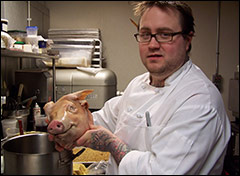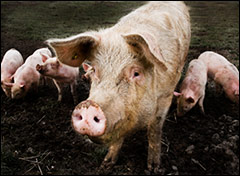
Ready to meat its maker.
A few months ago, I decided to force myself to confront issues surrounding meat-eating head on — so to speak — by attending a hog-butchering class. Taught by Boston chef Jamie Bissonnette of KO Prime and offered through the Chefs Collaborative, the class focused on utilizing the whole animal, from head to tail.
As usual, I was beset by the dilemma of what to wear. What looks attractive, creative, and professional — yet also looks good splattered in blood? I finally gave up trying to solve this particular sartorial puzzle and just decided to wear jeans and a T-shirt. As far as accessories go, I decided that this was probably not the moment to wear a charm bracelet.
My intern Anna joined me. A committed vegetarian, she too wanted to confront her ideas about meat-eating. Much of her childhood was spent in France where carnivory is an accepted and unquestioned part of life. She ate meat before going vegetarian three years ago.
Meat of the Matter
We had to check in at the door (it was like giving a password to get into a speakeasy during prohibition) to show that we were sincerely interested in learning about “whole-carcass breakdown” and that we weren’t anti-meat activists.
Once we got settled in, I was both relieved and disappointed to discover that this would be a demonstration rather than a participatory workshop. I wouldn’t get to confront my meat-eating issues as directly as I had expected to, but I wouldn’t go home covered in raw pig parts, either.
After some mingling (will I ever learn to enjoy mingling?) the demonstration got under way. Jamie placed a whole hog (although it had been eviscerated — i.e., the innards had already been removed) on the counter in front of us, with its little dead piggy eyes staring straight ahead — and right at us.
I wasn’t as disturbed as I expected — and perhaps even hoped — to be. For one thing, I’ve been cooking all my life and dealing with meat and poultry is second nature to me. Also, if you’re a cook, I think that there’s something inside of you that says, “People are counting on me to cook for them. I will do whatever is needed to deliver a delicious and nutritious meal.” You ignore your own feelings and perceptions in order to accomplish the task at hand. There’s no room or time for squeamishness.
Jamie worked his way from snout to tail, detailing all the ways in which he would use each cut. As he described each preparation (“this bit I’ll turn into head cheese, this I’ll use for choricio … “) I could hear Anna — committed vegetarian Anna — moan softly with pleasure. What can I say — you can take the girl out of France, but you can’t take France out of the girl.
By the end of the demonstration, Jamie had used the hog completely, leaving nothing behind but a bloodstain. Using the whole carcass makes sense on many levels. Not only is it less wasteful, but it also shows respect to the animal being eaten by not letting any of it go to waste, as well as being more responsible environmentally because it squeezes as much food value as possible out of each animal.
When the demonstration ended, we all had a chance to try some of the sausages, pâté, and headcheese that had been prepared for the crowd. And, of course, there was more mingling.

Jamie Bissonnette shows off a hog head.
Going in for the Kill
Jamie mentioned during the presentation that he had been a vegan during his teens, so Anna asked him how he went from being a vegan to a top butcher and chef. He answered that during his stages (internships) in French kitchens, the chefs to whom he was apprenticed told him if you want to be a great chef you need to know how to cook and handle meat. Hearing Jamie relate this story to Anna got me interested in interviewing him about how and why he made such a dramatic transition in his life. My in-depth interview with him will follow in the next column.
In the meantime, I found that this experience didn’t change my feelings about meat-eating at all. I eat very little meat for environmental reasons, but I don’t think that it’s morally wrong to eat a small amount now and then. Indeed, there are studies that show it’s more environmentally responsible to eat chicken than cheese since cows (which produce a lot of methane and consume a lot of grain) have to be maintained in order to produce the milk necessary to make cheese.
Also, I acknowledge that I am an animal that eats meat, just like many other animals. I understand that I don’t need to eat meat or poultry in order to stay alive, but I don’t feel that it’s wrong to include a little bit of meat in the mix of vegetables and grains that I do need to eat in order to sustain myself.
In short, I didn’t find that this experience really tested me, which leaves me to assume that only if I had to kill an animal would I ever really know what it means to cause suffering in my quest to eat meat. Maybe someday I will arrange to put myself squarely in the hot seat to see if my feelings change if I am directly responsible for taking an animal’s life, but for now I am OK with just eating very little meat and using it as wisely and thoroughly as I can.
Pâté Campagne
By Jamie Bissonnette
Makes 1 terrine or loaf pan size pâté
To make this pâté, Jamie recommends that you use a terrine mould or a loaf pan. He says not to worry about using exact amounts in this recipe, but to use it as a guide for what the ratio of ingredients should be (e.g., if you only have one pound of pork belly, make only half a batch).
Espelette is a kind of pepper. Jamie uses powdered Espelette.
1 pound of meat — pork, veal, chicken, venison, duck, rabbit, or a mix of any of them
1 pound liver, from any animal (kidneys and gizzards can be substituted; hearts will work, but only from poultry)
3 cups bread crumbs
6 large eggs
3/4 teaspoon curing salt (use Cure Salt #1)
Kosher salt, to taste
1/4 teaspoon powdered Espelette pepper
3/4 teaspoon mace, ground
1/4 cup Cognac, Armangac, or Brandy
6 slices bacon
Optional: 1 cup toasted hazelnuts or pistachios
Cut the first three ingredients into a 1/4 inch dice. Grind through a meat grinder on the 1/4 inch setting into a metal bowl resting on another bowl of ice. Mix in other ingredients. Scoop out a “test” spoonful and pan fry on a lightly oiled hot skillet until cooked. Taste for seasoning. Adjust with salt, Espelette, and mace as you see fit. Keep in mind that the pâté is served cold, and that flavors become somewhat muted as food cools, so adjust seasonings accordingly. When warm from the pan, the “test” mix may taste over-seasoned and even overly salty, but remember it will be less so when served cold. Fold in nuts if you are using them. This mixture is called a pâté farce.
Preheat oven to 325 F. Lay three slices of bacon length-wise into a terrine mold, roughly covering the bottom. Pack in the pâté farce. Top with the last three slices of bacon. Cover with foil. Bake in a water bath for 1 hour to 1 hour 45 minutes, or until the internal temperature reaches 150 degrees.
Allow to cool to room temperature, and then press with a 2-pound weight while cooling in the refrigerator. Wait at least one full day to eat this terrine.


